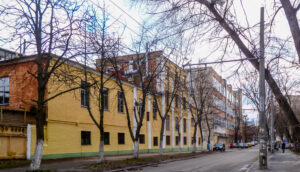
PrJSC Pokrovsky Mining and Processing Plant (PGZK, formerly Ordzhonikidze Mining and Processing Plant, Dnipropetrovsk region) reduced its net loss by 60% in January-September of this year compared to the same period last year — to UAH 218.489 million from UAH 545.746 million.
According to PGZK’s interim report for the first nine months of 2025, net income for this period increased by 6.1% to UAH 629.485 million. The uncovered loss at the end of September 2025 amounted to UAH 203.480 million.
As reported, in January-June of this year, PGZK reduced its net loss by 65.2% compared to the same period last year, to UAH 149.069 million from UAH 428.350 million, while net income for this period increased by 41.3% to UAH 479.767 million from UAH 339.617 million.
Based on its performance in 2023, PGZK increased its net loss 13 times compared to 2022, to UAH 624 million 48,108 thousand from UAH 47 million 932,515 thousand.
PGZK and Marganetsky GZK (MGZK, both in Dnipropetrovsk region), which are part of the Privat group, stopped mining and processing raw manganese ore in late October – early November 2023. In 2024, the plant was unable to resume operations due to a decline in demand for ferroalloys and a shortage of electricity.
In the first half of 2025, PGZK mined and enriched 22.87 thousand tons of manganese ore.
Four Cypriot companies — Profetis Enterprises Limited, Exseed Investmens Limited, Clemente Enterprises Limited, and Alexton Holdings Limited (all based in Cyprus) — each own 24.3024% of the private joint-stock company’s shares.
The authorized capital of the private joint-stock company is UAH 736.134 million, and the nominal value of a share is UAH 0.25.

The pharmaceutical company PJSC Kyiv Vitamin Plant (KVP) increased its net profit by 2.2 times in the first nine months of 2025 compared to the same period in 2024, to UAH 235.185 million.
According to the company’s disclosure to the National Securities and Stock Market Commission, net sales revenue for January-September 2025 increased by 2.5% to UAH 3.529 billion.
In January-September 2025, the company produced 35.770 million packages of medicines, for a total of UAH 4.268 576 billion at list prices.
The average selling price of one package of medicines produced by KVZ was UAH 133, the average cost of a package of KVZ dietary supplements was UAH 125, and medical products were UAH 263 per package.
In addition, the company reported that in the first nine months of 2025, KVZ exported products worth UAH 123.391 million, which is 3.5% of total sales. KVZ’s main export markets are Kazakhstan, Moldova, Latvia, Uzbekistan, and Israel.
The company plans to increase sales by 17.5% in 2025.
In addition, the company reported that total research and development expenses for the third quarter of 2025 amounted to UAH 5.246 million, which is almost twice as much as in the previous quarter.
The main distributors of KVZ products are BaDM LLC, Optima-Pharm, LTD, and VENTA. LTD.
The company reports that, based on the results of the first nine months of 2025, KVZ ranked fourth in the pharmaceutical market in terms of retail sales in monetary terms, with a market share of 3.29%.
As reported, KVZ increased its net profit by 8.74% compared to 2023, to UAH 156.84 million, and its revenue from sales of goods increased by 14.71% to UAH 4.944 billion in 2024.
KVZ is one of the ten largest pharmaceutical companies in Ukraine. The company’s product portfolio includes more than 100 medicines and 20 dietary supplements.
According to the Opendatabot system, the ultimate beneficiary of KVZ is Canadian citizen Maxim Martin.

In 2025, domestic pasta producers will, for the first time in the history of Ukraine’s independence, manufacture 50% of their products from durum wheat grown by domestic farmers, according to Rodion Rybchinsky, director of the Ukrainian Flour Millers Association.
“This year, for the first time, 50% of the durum wheat that we (pasta producers – IF-U) previously purchased abroad will be replaced by domestic wheat. If this trend continues, I think that Ukraine will stop importing durum wheat within the next two years,” he said at the Agro2Food Profit forum in Kyiv on Wednesday.
The expert attributed this import substitution to climate change in the country. Currently, the Mykolaiv, Odesa, Khmelnytskyi, and partially Vinnytsia regions are suitable for durum wheat production due to global warming, Rybchynskyi said.
The head of the industry association suggested that it is quite realistic that domestic processing enterprises will not be able to cope with the volume of durum wheat grown by farmers in the near future.
Rybchynskyi recalled that a mill is currently being built in the Lviv region to process durum wheat into pasta. At the same time, he noted that its capacity may not be sufficient to process all the durum wheat grown by farmers.
The head of the Ukrainian Flour Millers Association added that Ukrainian producers will definitely export such products, but the export volumes are unlikely to be comparable to those of Italy.
As reported, the private enterprise “Zakhidny Bug” is building Ukraine’s first mill that will process durum wheat, as well as a pasta factory. The mill is scheduled to start operating in October 2025, and the factory in September. The design capacity of the first stage of the mill is 80 tons per day for durum wheat and 150 tons per day for soft wheat varieties. The second phase will increase capacity by another 200 tons for durum and 300 tons for soft varieties. The total investment in the project will amount to UAH 1 billion.
Durum (Triticum durum – Latin) is a hard wheat with a high protein and gluten content, making it an ideal ingredient for pasta, bread, and other bakery products.

The agricultural group Ristone Holdings plans to complete the modernization of the acquired Kosarsky Distillery LLC at the end of October 2025, with production expected to start in November-December 2025, the agricultural holding’s press service reported on Facebook.
The agricultural group recalled that it acquired the distillery in August 2023 and received a license to produce undenatured ethyl alcohol in October 2024. This allowed it to begin a major modernization of the undenatured ethyl alcohol production line in February 2025, with a planned capacity of 36 tons/day. In addition, a new high-tech distillation and dehydration line is being prepared for launch at the distillery.
Ristone Holdings has already completed the reconstruction of existing workshops: boiler rooms; processing and cooking departments; installed a water treatment system and assembled a new gas pipeline.
“The key element of the investment project is the construction of a new distillation and dehydration line with a capacity of 60 tons/day. This is a modern technological complex designed to produce bioethanol of the highest degree of purification. The industrial scale of production at 60 tons/day will allow the plant to become a significant player in the Ukrainian market and meet the demand of large consumers,” the agricultural holding noted, adding that it plans to launch the bioethanol production project at the end of 2025.
Ristone Holdings is a vertically integrated agricultural holding company that includes: Dnipromlyn LLC, Bread Factory No. 10 LLC, Orilsky United Elevator LLC, Orilskaya Agricultural Firm LLC, Agroalliance LLC, Agrofirma Victoria, LLC, Agrofirma im. Gorkogo, STOV Zlagoda, etc.
Ristone Holdings cultivates 65.8 thousand hectares in the Dnipropetrovsk, Kharkiv, and Zaporizhzhia regions. It is engaged in the cultivation of grain and industrial crops, animal husbandry, production, and wholesale and retail trade in agricultural products, in particular, flour, bread, bakery products, etc.
In November 2021, the agricultural holding company acquired the Kosarsky Distillery (Kosari village, Smila, Cherkasy region) through Agrofirma im. Gorkogo LLC for UAH 162 million, which is three times more than the starting price. Ristone Holdings announced its intention to invest approximately UAH 130 million in the development of the acquired asset.
The founder and chairman of the supervisory board of Ristone Holdings is Vadym Nesterenko.

Since the start of the full-scale war, 88 flour mills have resumed operations in Ukraine, with 22 mills starting operations in 2024 and 10 in 2025, according to Rodion Rybchinsky, director of the Ukrainian Flour Millers Association.
“As of the end of 2021, there were 678 industrial enterprises operating in the grain processing sector in Ukraine. Unfortunately, during the full-scale invasion, we lost 192 enterprises. They either remained in temporarily occupied territories, were completely destroyed and ceased operations, or were partially damaged and suspended operations due to a lack of raw materials and logistics capabilities,” he said at the Agro2Food exhibition in Kyiv on Wednesday.
The expert noted that, starting in 2023, Ukraine began to restore its grain processing industry. Rybchynskyi attributed this to the problem with grain exports in 2022.
“Many agricultural producers saw a way out of the situation in opening grain processing facilities. They invested their funds. In addition, the state began to provide grants for reconstruction and capacity expansion,” he explained.
According to Rybchinsky, since the start of the full-scale war, 66 grain processing enterprises have resumed their work, and 22 enterprises started from scratch in 2024. At the same time, about 10 grain processing enterprises were launched in 2025.
Analyzing the specialization of the new plants, the head of the Ukrainian Flour Millers Association noted that 40% of the new enterprises are engaged in flour production, 30% produce cereals, and another 30% produce pasta. Geographically, the new enterprises are located in western and central Ukraine.
Rybchinsky emphasized that this refers specifically to the construction of new plants, not relocation, as processing enterprises depend on the existing raw material base and consumers. He also noted the complexity of transporting mills and finding new land plots.
According to the head of the Ukrainian Flour Millers Association, the cost of relocating a mill is about $1 million for its owners. According to Rybchynsky, the number of grain processing enterprises that have relocated their facilities can be “counted on the fingers of one hand.”
The expert added that as of 2024, Ukraine had produced 2.34 million tons of flour, which is 22% less than in 2021, before the war, when the country produced 3 million tons.

In January-September 2025, Euroins Ukraine (Kyiv) collected UAH 635.1 million in net premiums, which is 71.1% more than in the same period of 2024.
According to the company’s interim report posted on the information disclosure system of the National Securities and Stock Market Commission (NSSMC), its gross premiums for this period amounted to UAH 1.043 billion (more than 2.2 times). UAH 201.8 million was transferred to reinsurance (more than 2.4 times).
During the period, the company paid out UAH 204.9 million, which is 16.7% more than during the same period a year ago. At the same time, administrative expenses amounted to UAH 53.037 million, which is 49.2% higher than in January-September 2024.
The financial result from operating activities of IC Euroins Ukraine for nine months amounted to UAH 64.5 million, net profit – UAH 55.8 million, while a year earlier the loss amounted to UAH 10.060 million and UAH 24.439 million, respectively.
Euroins Ukraine is a universal non-life insurer that has been operating in the Ukrainian market since 1992. The company has 75 representative offices throughout the country and is licensed to provide insurance in 16 classes. It is actively involved in the segments of auto insurance, medical insurance, property insurance, liability insurance, and cargo insurance for private and corporate clients.
Euroins Ukraine Insurance Company is a member of the Motor (Transport) Insurance Bureau of Ukraine, the League of Insurance Organizations of Ukraine (LIOU), and the European Business Association (EBA).